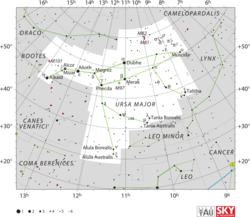Astronomy:Tau Ursae Majoris
| Observation data Equinox J2000.0]] (ICRS) | |
|---|---|
| Constellation | Ursa Major |
| Right ascension | 09h 10m 55.06553s[1] |
| Declination | +63° 30′ 49.0553″[1] |
| Apparent magnitude (V) | 4.66[2] |
| Characteristics | |
| Spectral type | kA5hF0mF5 II[3] |
| U−B color index | +0.14[2] |
| B−V color index | +0.35[2] |
| Astrometry | |
| Radial velocity (Rv) | −9.80±0.30[4] km/s |
| Proper motion (μ) | RA: +102.37[1] mas/yr Dec.: −63.55[1] mas/yr |
| Parallax (π) | 25.82 ± 0.54[1] mas |
| Distance | 126 ± 3 ly (38.7 ± 0.8 pc) |
| Absolute magnitude (MV) | +1.73[5] |
| Orbit[6] | |
| Period (P) | 1,062.4 d |
| Eccentricity (e) | 0.48 |
| Periastron epoch (T) | 2425721.6 JD |
| Argument of periastron (ω) (secondary) | 349.4° |
| Semi-amplitude (K1) (primary) | 3.9 km/s |
| Details | |
| τ UMa A | |
| Mass | 1.8±0.1[7] M☉ |
| Luminosity | 16[8] L☉ |
| Surface gravity (log g) | 3.86±0.43[9] cgs |
| Temperature | 7,343±100[9] K |
| Metallicity [Fe/H] | +0.57±0.15[9] dex |
| Rotational velocity (v sin i) | 21[10] km/s |
| Other designations | |
| Database references | |
| SIMBAD | data |
Tau Ursae Majoris (τ UMa) is the Bayer designation for a binary star in the northern circumpolar constellation of Ursa Major. It is visible to the naked eye, having an apparent visual magnitude of 4.66.[2] With an annual parallax shift of 25.82 mas,[1] it is located about 126 light years from the Sun. At that distance, the visual magnitude is diminished by an extinction factor of 0.19 due to interstellar dust.[9]
This is a single-lined spectroscopic binary star system with an orbital period of 2.9 years and an eccentricity of 0.48.[6] The primary member, component A, is an evolved bright giant with a stellar classification of kA5hF0mF5 II.[3] This notation indicates the star's spectrum shows the calcium K lines of an A5 star, the hydrogen lines of an F0 star, and the metallic lines of an F5 star.[12] It is an evolved Am star of the ρ Puppis type, a class of evolved stars showing the Am chemical peculiarities.[13] It is located in the instability strip of the Hertzsprung–Russell diagram but is not thought to be variable.[7]
Naming
With φ, h, υ, θ, e, and f, it composed the Arabic asterism Sarīr Banāt al-Na'sh, the Throne of the daughters of Na'sh, and Al-Haud, the Pond.[14] According to the catalogue of stars in the Technical Memorandum 33-507 - A Reduced Star Catalog Containing 537 Named Stars, Al-Haud were the title for seven stars : f as Alhaud I, this star (τ) as Alhaud II, e as Alhaud III, h as Alhaud IV, θ as Alhaud V, υ as Alhaud VI and φ as Alhaud VII .[15]
References
- ↑ 1.0 1.1 1.2 1.3 1.4 1.5 van Leeuwen, F. (2007), "Validation of the new Hipparcos reduction", Astronomy and Astrophysics 474 (2): 653–664, doi:10.1051/0004-6361:20078357, Bibcode: 2007A&A...474..653V.
- ↑ 2.0 2.1 2.2 2.3 Mermilliod, J.-C. (1986), "Compilation of Eggen's UBV data, transformed to UBV (unpublished)", Catalogue of Eggen's UBV Data (SIMBAD), Bibcode: 1986EgUBV........0M.
- ↑ 3.0 3.1 Gray, R. O. et al. (July 2006), "Contributions to the Nearby Stars (NStars) Project: spectroscopy of stars earlier than M0 within 40 pc-The Southern Sample", The Astronomical Journal 132 (1): 161–170, doi:10.1086/504637, Bibcode: 2006AJ....132..161G.
- ↑ de Bruijne, J. H. J.; Eilers, A.-C. (October 2012), "Radial velocities for the HIPPARCOS-Gaia Hundred-Thousand-Proper-Motion project", Astronomy & Astrophysics 546: 14, doi:10.1051/0004-6361/201219219, A61, Bibcode: 2012A&A...546A..61D.
- ↑ Anderson, E.; Francis, Ch. (2012), "XHIP: An extended hipparcos compilation", Astronomy Letters 38 (5): 331, doi:10.1134/S1063773712050015, Bibcode: 2012AstL...38..331A.
- ↑ 6.0 6.1 Pourbaix, D.; Tokovinin, A. A.; Batten, A. H.; Fekel, F. C.; Hartkopf, W. I. et al. (2004), "SB9: The ninth catalogue of spectroscopic binary orbits", Astronomy & Astrophysics 424 (2): 727–732, doi:10.1051/0004-6361:20041213, Bibcode: 2004A&A...424..727P.
- ↑ 7.0 7.1 Burkhart, C. et al. (January 2005), "The field Am and ρ Puppis-like stars: Lithium and heavier elements", Astronomy and Astrophysics 429 (3): 1043–1049, doi:10.1051/0004-6361:20040467, Bibcode: 2005A&A...429.1043B.
- ↑ McDonald, I. et al. (2012), "Fundamental Parameters and Infrared Excesses of Hipparcos Stars", Monthly Notices of the Royal Astronomical Society 427 (1): 343–57, doi:10.1111/j.1365-2966.2012.21873.x, Bibcode: 2012MNRAS.427..343M.
- ↑ 9.0 9.1 9.2 9.3 Koleva, M.; Vazdekis, A. (February 2012), "Stellar population models in the UV. I. Characterisation of the New Generation Stellar Library", Astronomy & Astrophysics 538: A143, doi:10.1051/0004-6361/201118065, Bibcode: 2012A&A...538A.143K.
- ↑ Royer, F. et al. (October 2002), "Rotational velocities of A-type stars in the northern hemisphere. II. Measurement of v sin i", Astronomy and Astrophysics 393: 897–911, doi:10.1051/0004-6361:20020943, Bibcode: 2002A&A...393..897R.
- ↑ "tau UMa". SIMBAD. Centre de données astronomiques de Strasbourg. http://simbad.u-strasbg.fr/simbad/sim-basic?Ident=tau+UMa.
- ↑ Gray, Richard O.; Corbally, J. (2009), Stellar Spectral Classification, Princeton University Press, pp. 178, ISBN 978-0691125114.
- ↑ Zaremba, D. (1979), "On the determination of the stellar chemical composition. I - Tau UMa", Acta Astronomica 29 (4): 573–586, Bibcode: 1979AcA....29..573Z.
- ↑ Allen, Richard Hinckley (1899), Star-Names and Their Meanings, New York: G. E. Stechert, p. 442.
- ↑ Rhoads, Jack W. (November 15, 1971), Technical Memorandum 33-507-A Reduced Star Catalog Containing 537 Named Stars, Jet Propulsion Laboratory, California Institute of Technology, https://ntrs.nasa.gov/archive/nasa/casi.ntrs.nasa.gov/19720005197_1972005197.pdf.
 |


